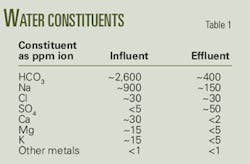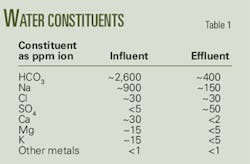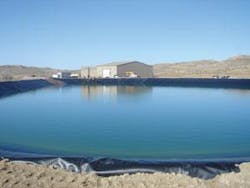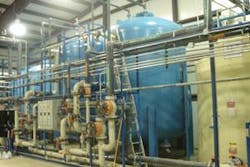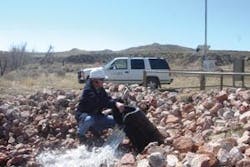A recently completed plant in the Power River basin in Wyoming uses a new method for treating water produced from coalbed methane (CBM) wells.
The new fixed-bed dynamic flow ion exchange system provides better cost efficiency and less waste byproduct than other processes. The process has a hybrid design. It simulates all the advantages of moving resins or media beds in a fixed-bed design, and it minimizes wastes by diverting rinse portions, rather than resins or beds.
The fixed-bed design can easily cope with resin expansion associated with weak acid cation resins.
CBM water
Produced water from CBM wells has limited rapid expansion of gas production from these resources.
The coal seam waters invariably have high bicarbonate ion levels. Sodium associated with bicarbonate alkalinity poses serious environmental threats to farming and ranching. While many novel treatment processes have been promoted, ion exchange and reverse osmosis are the only technologies deployed so far.
When waste volume is the most important determinant for system costs, reverse osmosis systems have difficulty competing with ion exchange systems, even with no waste minimization techniques, for waters with less than 5,000-ppm total dissolved solids (TDS).
Table 1 briefly compares reverse osmosis, ion exchange, and electrochemical processes during treatment of water characterized by the analysis in Table 2.
Sodium removal with ion exchange is an established technology. The technology, however, traditionally produces large volumes of regeneration waste, making disposal cost prohibitive and ultimately affecting the CBM well operating costs. Hence, the industry has had limited success in the Wyoming region with ion exchange systems not designed to minimize regeneration waste.
Low waste ion exchange systems have a history in the nuclear and sugar processing industries. While a significant improvement over conventional ion exchange systems, these systems are not optimized for CBM water. Much higher cost savings are achieved by a process specifically designed for water with this signature characteristic.
Alkalinity associated cations (as in sodium bicarbonate) can be removed with very high capacities with a weak acid cation (WAC) ion exchange resin. The carboxylic acid functionality of this resin only targets the alkalinity associated sodium, aiming to neutralize the alkalinity.
As a result, the process produces effluent water with a pH that can be directly discharged without any adjustment.
By contrast, most ion exchange systems (if not all) currently deployed in the CBM field use strong acid cation (SAC) resins, which have lower operating capacities and require 100-200% stoichiometric excess of acid to regenerate. (See reactions box.)
While capacities of SAC resins are enhanced in the alkalinity neutralization function, they still do not match the high capacities or near stoichiometric acid requirements of WAC resins. WAC resins, however, have characteristics that make the system design very special.
The benefits of WACs include high capacity, virtually 100% acid utilization resulting in no acid wasted, effluent pH within discharge limits.
A negative is that WACs expand 80-90% upon exhaustion.
With high bicarbonate-level associated sodium, the most efficient means to remove sodium is with a weak acid cation resin, regenerated with sulfuric acid. The existing technologies minimize waste with what may be called dynamic system design. Either the resin or the resin bed is moved to optimize rinsing cycles. Such systems would need to be redesigned to cope with large variations in the resin volume or density, thus they currently use strong acid cation resins.
This single design limitation forces the forfeiting of 50% or more of maximum possible capacity from a volume of resin. Additionally, strong acid resins require stoichiometric excess of 100-200% acid for regeneration, producing an acidic waste, requiring neutralization.
Custom designed system
After successfully passing the Wyoming Department of Environmental Quality water quality tests, RG Global’s Catalyx Fluid Solutions division recently launched commercial production of its first plant employing the patent pending fixed-bed dynamic flow ion exchange system specifically designed to treat discharge water from coalbed methane wells.
The multimillion dollar plant, the first phase of three phases and part of a 5-year, $20-22 million gross revenue build-own-and-operate contract with Yates Petroleum Corp., currently has a capacity to treat 30,000 b/d of coalbed water and can be operated continuously at 120% of capacity (Fig. 1).
Located about 35 miles west of Gillette, Wyo., in the Powder River basin, the plant employs the new proprietary ion exchange technology to clean the water more cost efficiently and with less waste byproduct than other methods currently in use.
It incorporates the following design steps that enable the system to produce a small, concentrated regenerant:
- System first utilizes an aluminosilicate (zeolite) filtration media as a prefiltration step. The use of a mineral instead of multimedia filters removes dissolved iron, which is fluffed off during backwash, when air is used for scouring.
- The first-stage ion exchange unit is a countercurrent, upflow packed-bed system with 100% freeboard at start of service cycle. Upflow service eliminates any gas pockets formed due to bicarbonate conversion to CO2.
- When the sodium bicarbonate levels are high, the CO2-generated by the first stage is followed by a degasification step.
- The degasification step is followed by a second-stage unit identical to the first stage.
- A final degasifier eliminates CO2 formed during the second stage, and water is then discharged.
The fixed-bed dynamic flow ion exchange system occupies about 2,000 sq ft of floor space for every 30,000 b/d capacity plant.
Waste minimization
The primary advantage of the process is evident during the regeneration procedure. The processe uses three storage tanks to break the regeneration cycle into segments (Fig. 2).
The first cycle consists of pumping a premixed acid volume through the resin bed, in a counter current manner.
During the first cycle, the process water from the columns is diverted to the feed pond.
The concentrated acid is completely adsorbed by the resin, producing a rich stream of sodium sulfate.
The second cycle pumps rinse water from a second tank and starts rinsing the resin. This rinse is saved in the tank used for pre-mixing acid for the next regeneration cycle.
The third cycle pumps rinse water from a third tank and further rinses the resin. This rinse is saved in the tank used for the first rinse in the next regeneration cycle.
The fourth cycle takes treated water and rinses the resin completely, and the water is saved in the tank used for the second rinse in the next regeneration cycle.
The waste produced from the regeneration is typically equivalent to less than one bed volume of resin. Given that the resin has two to three times the capacity of strong acid cation resins, the already low regenerant volume helps further reduce the waste per barrel.
Sulfuric acid advantages
The process uses sulfuric acid as a proton source that will allow the operators to eliminate completely liquid-waste discharge from the site.
Currently under way at the project is implementation of Stage Two that includes installing a system for varying the temperature of the very low volume of waste and crystallizing sodium sulfate decahydrate or anhydrous sodium sulfate.
This resulting product can be sold to industries as industrial grade raw material.
No chlorides
The recently installed plant has a 30,000-b/d capacity and can operate 24 hr with remote web-based controls. The use of sulfuric acid further helps meet upcoming stringent chloride limits in the Powder River basin.
Hydrochloric acid use for ion exchange regeneration by other systems may produce leakage of chlorides that may not meet discharge standards.
Minimal environmental impact
The fixed-bed dynamic flow ion exchange system was designed for long-term large-scale implementation. Average electrical conductivity in the Powder River is 1,900 µsec/cm. Discharging large volumes of water into the river can affect the overall salinity of the river. There are concerns from wildlife conservation specialists that certain organisms have evolved to exist in this level of sodium and salinity. If the produced CBM water is purified beyond the levels of sodium in the river, it is postulated such wildlife would be affected adversely.
As shown in Table 2, sodium bicarbonate dominates the water analysis; hence, a sodium-removal approach on the entire stream would desalinate the water beyond the required as well as desired amounts. It was important, therefore, to design the plant with an automated, proportionally controlled blending valve. The process aims to discharge water with sodium levels close to existing levels in the river. This approach has two benefits:
- It reduces the total water volume treated, thereby improving treatment economics.
- Within the next year, when more than 120,000 b/d will be discharged into the river, the overall sodium level in the river will not be disturbed.
Fig. 3 shows an operator taking a sample of the water effluent.
The author
Juzer Jangbarwala ([email protected]) is chief technology officer and chairman of RG Global Lifestyles Inc., Anaheim. Previously he founded and was CEO of Hydromatix Inc. In 2002, he founded and became CEO of Catalyx Inc. In 2004, he founded and became CEO of Energix Research Inc., a spinoff of Catalyx Inc. In 2006, Catalyx Inc. spun off CPS Inc., and Jangbarwala serves as its chief technology officer to develop water treatment technologies from the Catalyx portfolio of patents. Jangbarwala holds a BS in chemical engineering from Lehigh University.
